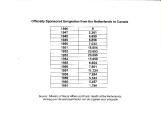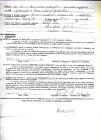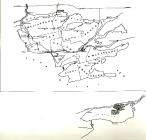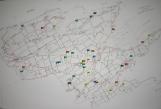1
Following the Second World War, Canada faced a shortage of farm labour. The government in the Netherlands encouraged immigration to aid in that country's reconstruction. The Netherlands-Canadian settlement scheme was a successful program that met the needs of both nations. Between 1947 and 1960 there were 142,453 officially sponsored immigrants to Canada from the Netherlands. Canada was the most common destination for Dutch immigrants, followed by Australia (112,148) and the United States (62,057).3
Initially the program was only open to experienced farmers and their families. They agreed to work for a minimum of 1 year as labourers for the Canadian farmers who sponsored them. The Canadian farmers were required to provide housing and to pay single men a minimum of $45 per month and married men $75 per month. Over time the regulations relaxed and individuals with business, technical or professional experience also became eligible. Many of the first settlers were able to sponsor relatives or friends from home, provided that they could find someone willing to guarantee work for the new arrival.6
Application completed by Henry Nyman in November 1952 to sponsored his older brother and sister-in-law Willem & Drike Nyman. Henry had arrived in Canada in May 1951. Donald Ross of Bloomfield guaranteed housing and employment. Bill Nyman now operates a dairy farm in Bloomfield.8
Prince Edward County is a peninsula, jutting into Lake Ontario, south of the city of Belleville, Ontario. Picton, its administrative centre, is located 220 km east of Toronto and 50 km west of Kingston. The construction of the Murray Canal in the late 1880s, turned the peninsula into a man-made island.9
Its economy is based on agriculture, with a strong shipping and fishing tradition. From the 1880s the county became a centre of the canning industry. During the period of Dutch immigration the canneries were still a significant employer, although it coincided with the beginning of their decline.Prince Edward County was first settled by United Empire Loyalists in 1784, at the conclusion of the American Revolution. It reached a peak population of 20,869 in 1860, a number that was not surpassed until the late twentieth century, in part due to the infusion of Dutch immigrants. Many inhabitants can count back seven or eight generations who have resided in the County and can trace a complex web of interrelationships.
10
Interestingly some of the first Loyalist settlers were descended from the Dutch settlement of New Amsterdam in what is now New York State, and were Dutch speaking. The Van Allstein family received significant grants of land in Prince Edward County and built the first mill at Glenora. By the mid-twentieth century these families had completely assimilated to the dominant English culture and only their last names provide clues to this earlier Dutch Heritage.12
A few Dutch families arrived in Prince Edward County in the fall of 1947. The settlement scheme rapidly expanded the next year. On June 25, 1948 The Picton Gazette announced the arrival of 57 families in Prince Edward County, noting that "a few of these are single men, but for the most part there are parents and several children in each group." The article provided the name of each Dutch head of household, the name of his sponsor and the rural route where they resided. This map attempts to locate as many of these residences as possible. Although some are missing, it demonstrates that Dutch families were widely distributed through the county.13
Clearly the influx of immigrants on this scale into a relatively small and stable population had a profound impact. Many of those who first settled in Prince Edward County under the Settlement Scheme moved on, purchasing farms elsewhere or finding employment in larger urban centres. A significant number remained, putting down roots in the community. Their willingness to work hard, as a family unit, to succeed in their new country echoed the experience of earlier settlers and won them respect. Many families now count four generations in Canada. Since many of the first arrivals sponsored relatives and subsequent generations married, the web of kinship in the Dutch community is as dense as in "Old County" families.14
The experiences of the Dutch immigrants who came to Canada between 1947 and 1960 contain other parallels to earlier settlers:* the difficult decision to leave home due to adverse circumstances
* a belief that they would never see family and friends again
* a lack of knowledge about their destination
* determination or faith that they would forge a better future
* the discomforts of the journey
* early challenges and homesickness
* establishing themselves in a new land.
Their first hand accounts of the immigrant experience are moving. They also help bring to life the experiences of those earlier settlers whose voices were not recorded.




